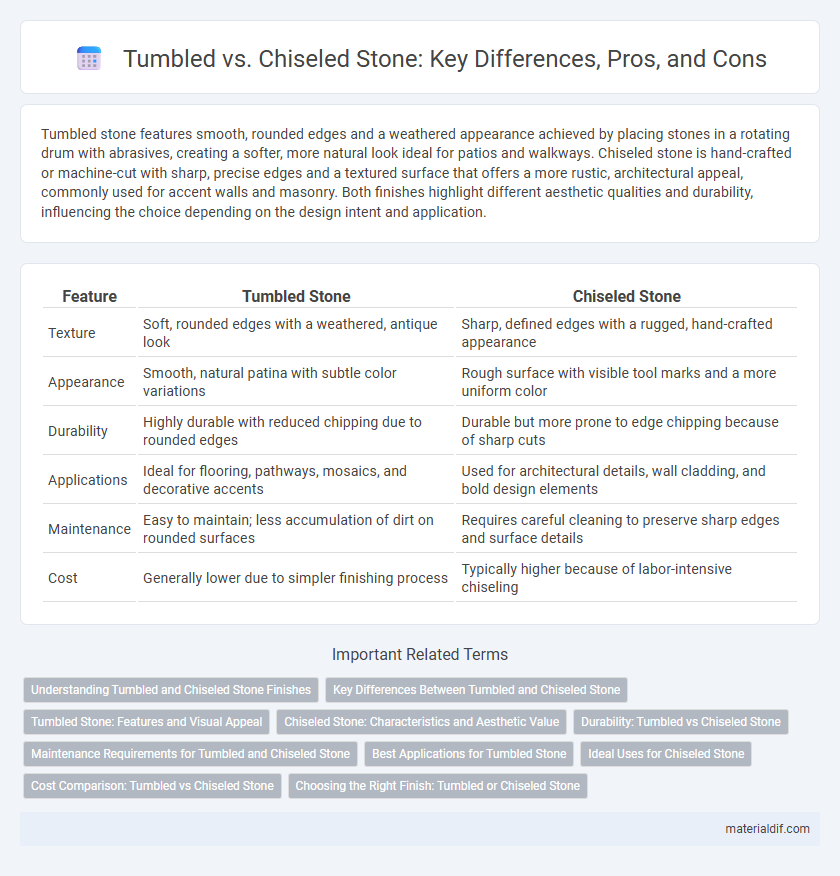Tumbled stone features smooth, rounded edges and a weathered appearance achieved by placing stones in a rotating drum with abrasives, creating a softer, more natural look ideal for patios and walkways. Chiseled stone is hand-crafted or machine-cut with sharp, precise edges and a textured surface that offers a more rustic, architectural appeal, commonly used for accent walls and masonry. Both finishes highlight different aesthetic qualities and durability, influencing the choice depending on the design intent and application.
Table of Comparison
| Feature | Tumbled Stone | Chiseled Stone |
|---|---|---|
| Texture | Soft, rounded edges with a weathered, antique look | Sharp, defined edges with a rugged, hand-crafted appearance |
| Appearance | Smooth, natural patina with subtle color variations | Rough surface with visible tool marks and a more uniform color |
| Durability | Highly durable with reduced chipping due to rounded edges | Durable but more prone to edge chipping because of sharp cuts |
| Applications | Ideal for flooring, pathways, mosaics, and decorative accents | Used for architectural details, wall cladding, and bold design elements |
| Maintenance | Easy to maintain; less accumulation of dirt on rounded surfaces | Requires careful cleaning to preserve sharp edges and surface details |
| Cost | Generally lower due to simpler finishing process | Typically higher because of labor-intensive chiseling |
Understanding Tumbled and Chiseled Stone Finishes
Tumbled stone features a weathered, smooth surface created by tumbling stones with abrasives, resulting in rounded edges and a natural, rustic appearance ideal for outdoor pathways and patios. Chiseled stone exhibits a sharp, textured finish made by manually hacking the edges with a chisel, providing a more refined and architectural look often used in wall cladding and decorative facades. Choosing between tumbled and chiseled finishes depends on the desired aesthetic, texture, and application in landscaping or construction projects.
Key Differences Between Tumbled and Chiseled Stone
Tumbled stone features a smooth, rounded surface achieved through mechanical tumbling, creating a weathered, antique appearance ideal for rustic aesthetics. Chiseled stone displays sharp, angular edges formed by hand or machine chiseling, providing a more textured, natural finish suitable for architectural and landscaping applications. The key differences lie in texture, edge sharpness, and overall visual appeal, with tumbled stone offering softness and chiseled stone emphasizing ruggedness.
Tumbled Stone: Features and Visual Appeal
Tumbled stone features rounded edges and a smooth, weathered surface achieved through a tumbling process that mimics natural erosion. Its rustic, aged appearance adds warmth and character to patios, walkways, and interior designs. The variety of colors and textures available enhances its versatility for both traditional and contemporary aesthetics.
Chiseled Stone: Characteristics and Aesthetic Value
Chiseled stone features a textured surface created by carving with a hammer and chisel, resulting in a rough, rugged appearance that enhances the natural beauty of the material. This technique emphasizes sharp edges and intricate details, making chiseled stone ideal for decorative architectural elements, facades, and pathways that require a distinctive, artisanal look. Compared to tumbled stone, chiseled stone offers increased durability and a more pronounced, tactile surface, contributing significantly to both structural integrity and aesthetic value.
Durability: Tumbled vs Chiseled Stone
Tumbled stone features a softened surface with rounded edges due to the tumbling process, which enhances its resistance to wear and erosion, making it highly durable for outdoor applications. Chiseled stone displays sharp, precise edges created by hand tools, resulting in a textured surface that may be more susceptible to chipping under heavy impact but offers solid structural strength. Both finishes provide durability suited to different architectural needs, with tumbled stone excelling in longevity against weathering and chiseled stone favored for load-bearing and decorative accents.
Maintenance Requirements for Tumbled and Chiseled Stone
Tumbled stone requires regular sealing and gentle cleaning to maintain its textured, weathered appearance and prevent dirt buildup in its porous surface. Chiseled stone demands less frequent sealing but benefits from routine dusting and washing to preserve its sharp edges and prevent accumulation of debris in the rough grooves. Both finishes benefit from avoiding harsh chemicals, but tumbled stone's softer surface necessitates more careful maintenance to avoid wear.
Best Applications for Tumbled Stone
Tumbled stone is best suited for applications requiring a weathered, rustic appearance with a smooth, rounded texture, such as garden pathways, patios, and decorative walls. Its non-slip surface and softer edges make it ideal for outdoor use where safety and aesthetic blend seamlessly. The versatility of tumbled stone allows it to enhance both traditional and contemporary landscape designs.
Ideal Uses for Chiseled Stone
Chiseled stone features a textured, hand-crafted appearance that enhances architectural details and adds a rustic charm to both interior and exterior designs. Ideal uses for chiseled stone include accent walls, fireplace surrounds, and garden pathways where a natural, rugged aesthetic is desired. Its durability and unique texture make it suitable for creating focal points in landscaping and masonry projects that require a refined yet sturdy finish.
Cost Comparison: Tumbled vs Chiseled Stone
Tumbled stone generally costs less than chiseled stone due to its less labor-intensive finishing process, where natural abrasion creates a weathered, rounded appearance. Chiseled stone requires skilled craftsmanship to produce sharp, defined edges, leading to higher labor expenses and increased overall cost. Pricing varies by stone type and region but expect tumbled stone to offer a more budget-friendly choice for projects requiring rustic textures.
Choosing the Right Finish: Tumbled or Chiseled Stone
Tumbled stone offers a smooth, weathered appearance achieved through a tumbling process that softens edges, ideal for rustic or natural aesthetics. Chiseled stone features sharp, precise edges created by manual or mechanical chiseling, providing a more structured and refined look suitable for formal or architectural designs. Selecting between tumbled and chiseled stone depends on the desired texture, durability requirements, and overall style of the project.
Tumbled vs Chiseled Infographic

 materialdif.com
materialdif.com